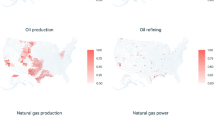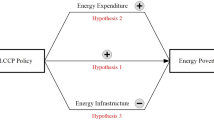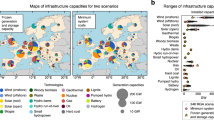Abstract
The path towards decarbonization promises many societal benefits such as reduced greenhouse gas emissions and new technological innovation. The adverse effects of policies that are helping to facilitate the energy transition, such as price spikes or job displacement, however, are not evenly spread across the population, and some individuals and communities are more vulnerable to possible adverse impacts than others. Here, we adapt a framework for conceptualizing vulnerability from the climate change adaptation literature to the energy context. We construct the dimensions of the framework, provide an illustration using the case of the renewable portfolio standard, generate a vulnerability score measure and map vulnerability across US counties. Our analysis shows that this framework can be used to identify geographical disparities, and should be further developed in future research to provide deeper insights about a just transition.
This is a preview of subscription content, access via your institution
Access options
Access Nature and 54 other Nature Portfolio journals
Get Nature+, our best-value online-access subscription
$29.99 / 30 days
cancel any time
Subscribe to this journal
Receive 12 digital issues and online access to articles
$119.00 per year
only $9.92 per issue
Buy this article
- Purchase on Springer Link
- Instant access to full article PDF
Prices may be subject to local taxes which are calculated during checkout



Similar content being viewed by others
References
Solomon, B. D. & Krishna, K. The coming sustainable energy transition: history, strategies, and outlook. Energy Policy 39, 7422–7431 (2011).
Allen, R. C. Backward into the future: the shift to coal and implications for the next energy transition. Energy Policy 50, 17–23 (2012).
Hernandez, D. Sacrifice along the energy continuum: a call for energy justice. Environ. Justice 8, 151–156 (2015).
Sovacool, B. K. & Dworkin, M. H. Energy justice: conceptual insights and practical applications. Appl. Energy 142, 435–444 (2015).
Miller, C. A., Iles, A. & Jones, C. F. The social dimensions of energy transitions. Science as Culture 22, 135–148 (2013).
Jenkins, K., McCauley, D., Heffron, R., Stephan, H. & Rehner, R. Energy justice: a conceptual review. Energy Res. Soc. Sci. 11, 174–182 (2016).
McCauley, D. A., Heffron, R. J., Stephan, H. & Jenkins, K. Advancing energy justice: the triumvirate of tenets. Int. Energy Law Rev. 32, 107–110 (2013).
Blonz, J., Burtraw, D. & Walls, M. Social safety nets and US climate policy costs. Clim. Policy 12, 474–490 (2012).
Williams, R., Gordon, H., Burtraw, D., Carbone, J. & Morgenstern, R. The Initial Incidence of a Carbon Tax Across US States 14–24 (Resources for the Future, 2014).
IPCC: Summary for Policymakers. In Climate Change 2014: Impacts, Adaptation and Vulnerability (eds Field, C. B. et al.) 1–32 (Cambridge Univ. Press, Cambridge, 2014).
Coletti, A., De Nicola, A. & Villani, M. L. Building climate change into risk assessments. Nat. Hazards 84, 1307–1325 (2016).
Howe, P. D., Yarnal, B., Coletti, A. & Wood, N. J. The participatory vulnerability scoping diagram: deliberative risk ranking for community water systems. Ann. Assoc. Am. Geogr. 103, 343–352 (2013).
Füssel, H. M. & Klein, R. J. Climate change vulnerability assessments: an evolution of conceptual thinking. Clim. Change 75, 301–329 (2006).
Brooks, N. Vulnerability, Risk and Adaptation: a Conceptual Framework Research (Tyndall Centre for Climate Change, 2003).
Smit, B. & Wandel, J. Adaptation, adaptive capacity and vulnerability. Glob. Environ. Change 16, 282–292 (2006).
Eriksen, S. H. & Kelly, P. M. Developing credible vulnerability indicators for climate adaptation policy assessment. Mitig. Adapt. Strat. Glob. Change 12, 495–524 (2007).
Polsky, C., Neff, R. & Yarnal, B. Building comparable global change vulnerability assessments: The vulnerability scoping diagram. Glob. Environ. Change 17, 472–485 (2007).
Coletti, A., Howe, P. D., Yarnal, B. & Wood, N. J. A support system for assessing local vulnerability to weather and climate. Nat. Hazards 65, 999–1008 (2013).
Kahn, M. E. & Mansur, E. T. Do local energy prices and regulation affect the geographic concentration of employment? J. Pub. Econ. 101, 105–114 (2013).
Upton, G. B. & Snyder, B. F. Funding renewable energy: an analysis of renewable portfolio standards. Energy Econ. 66, 205–216 (2017).
Fischer, C. & Burtraw, D. Cost-effectiveness of renewable electricity policies. Energy Econ. 27, 873–894 (2005).
Fischer, C. Renewable portfolio standards: when do they lower energy prices? Energy J. 31, 101–119 (2010).
Kydes, A. Impacts of a renewable portfolio generation standard on US energy markets. Energy Policy 35, 809–14 (2007).
Tra, C. Have renewable portfolio standards raised electricity rates? Evidence from US electric utilities. Contemp. Econ. Policy 34, 184–189 (2015).
Wiser, R. & Bolinger, M. Can deployment of renewable energy put downward pressure on natural gas prices? Energy Policy 35, 295–306 (2007).
Born, P. The economic effects of energy price shocks. J. Econ. Lit. 46, 871–909 (2008).
Alberini, A., Gans, W. & Velez-Lopez, D. Residential consumption of gas and electricity in the US: The role of prices and income. Energy Econ. 33, 870–881 (2011).
Poyer, D. A. & Williams, M. Residential energy demand: additional empirical evidence by minority household type. Energy Econ. 15, 93–100 (1993).
Poyer, D. A., Henderson, L. & Teotia, A. P. Residential energy consumption across different population groups: comparative analysis for Latino and non-Latino households in USA. Energy Econ. 19, 445–463 (1997).
Reames, T. G. Targeting energy justice: Exploring spatial, racial/ethnic and socioeconomic disparities in urban residential heating energy efficiency. Energy Policy 97, 549–558 (2016).
Ribeiro, D. et al. The 2017 City Energy Efficiency Scorecard (American Council for anEnergy-Efficient Economy, 2017).
Tompkins, E. & Adger, W. N. Does adaptive management of natural resources enhance resilience to climate change? Ecol. Soc. 9, 10 (2004).
Hsiang, S. et al. Estimating economic damage from climate change in the United States. Science 356, 1362–1369 (2017).
Cutter, S. L., Ash, K. D. & Emrich, C. T. The geographies of community disaster resilience. Glob. Environ. Change 29, 65–77 (2014).
Bhattacharya, J., DeLeire, T., Haider, S. & Currie, J. Heat or eat? Cold-weather shocks and nutrition in poor American families. Am. J. Public Health 93, 1149–1154 (2003).
Reames, T. G. A community-based approach to low-income residential energy efficiency participation barriers. Local Environ. 21, 1449–1466 (2016).
Thompson, A. L. Protecting Low-Income Ratepayers as the Electricity System Evolves. Energy Law J. 37, 265–306 (2016).
Cragg, M. I., Zhou, Y., Gurney, K. & Kahn, M. E. Carbon geography: the political economy of congressional support for legislation intended to mitigate greenhouse gas production. Econ. Inq. 51, 1640–1650 (2013).
SimplyAnalytics (2017). EASI/MRI Consumer Expenditure Data 2016. Retrieved 15 March 2018 from SimplyAnalytics database.
USAspending.gov. 2009. Archived Web Site. Retrieved from the Library of Congress (Accessed 15 March 2018); https://www.loc.gov/item/lcwa00093149/.
Tickamyer, A. R. & Duncan, C. M. Poverty and opportunity structure in rural America. Annu. Rev. Sociol. 16, 67–86 (1990).
ArcGIS Desktop 10.5. (ESRI, 2016).
Price, C. W., Brazier, K. & Wang, W. Objective and subjective measures of fuel poverty. Energy Policy 49, 33–39 (2012).
Kammen, D. M., Kapadia, K. & Fripp, M. Putting Renewables to Work: How Many Jobs Can the Clean Energy Industry Generate?. (University of California, Berkeley, 2004).
Seefeldt, K. S. Constant consumption smoothing, limited investments, and few repayments: The role of debt in the financial lives of economically vulnerable families. Soc. Serv. Rev. 89, 263–300 (2015).
Bennett, A. & Loomis, J. Are housing prices pulled down or pushed up by fracked oil and gas wells? A Hedonic price analysis of housing values in Weld County, Colorado. Soc. Nat. Res. 28, 1168–1186 (2015).
Gopalakrishnan, S. & Klaiber, H. A. Is the shale energy boom a bust for nearby residents? Evidence from housing values in Pennsylvania. Am. J. Agric. Econ. 96, 43–66 (2013).
Heintzelman, M. D. & Tuttle, C. M. Values in the wind: a hedonic analysis of wind power facilities. Land Econ. 88, 571–588 (2012).
Atkinson-Palombo, C. & Hoen, B. Relationship Between Wind Turbines and Residential Property Values in Massachusetts (University of Connecticut, 2014).
Muehlenbachs, L., Spiller, E. & Timmins, C. Shale Gas Development and Property Values Differences Across Drinking Water Sources (National Bureau of Economic Research, 2012).
Konisky, D. M. & Reenock, C. Regulatory enforcement, riskscapes, and environmental justice. Policy Stud. J. 46, 7–36 (2017).
Acknowledgements
The authors would like to acknowledge financial support for this project offered by the Indiana University’s Office for the Vice Provost for Research through the IU Collaborative Research Grant. B.Wiley and L. Platzer provided valuable research assistance. Helpful feedback was offered on an earlier version of this manuscript by T. Fitzgerald, R. Gifford, K. Gillingham, M. Kahn, T. Kavulla, R. Kellogg, L. Kiesling, C. Kulander, I. Lange, J. Makholm, S. Masten, L. Muehlenbachs, A. Ohler, S. Puller, D. Williamson and F. Wolak.
Author information
Authors and Affiliations
Contributions
All authors developed the concept for the paper and conducted the analysis. M.G. gathered the quantitative data. S.C., M.G., and D.K. co-wrote the paper. T.E. developed the maps and edited the paper.
Corresponding author
Ethics declarations
Competing interests
The authors declare no competing interests.
Additional information
Publisher’s note: Springer Nature remains neutral with regard to jurisdictional claims in published maps and institutional affiliations.
Rights and permissions
About this article
Cite this article
Carley, S., Evans, T.P., Graff, M. et al. A framework for evaluating geographic disparities in energy transition vulnerability. Nat Energy 3, 621–627 (2018). https://doi.org/10.1038/s41560-018-0142-z
Received:
Accepted:
Published:
Issue Date:
DOI: https://doi.org/10.1038/s41560-018-0142-z
This article is cited by
-
A low-carbon electricity sector in Europe risks sustaining regional inequalities in benefits and vulnerabilities
Nature Communications (2023)
-
Location is a major barrier for transferring US fossil fuel employment to green jobs
Nature Communications (2023)
-
A dataset of low-carbon energy transition index for Chinese cities 2003–2019
Scientific Data (2023)
-
Can carbon emission reduction mitigate the PM2.5 air pollution? Evidence of the co-benefits from mitigating climate change
Environment, Development and Sustainability (2023)
-
Effect of sub-indicator weighting schemes on the spatial dependence of multidimensional phenomena
Journal of Geographical Systems (2023)



